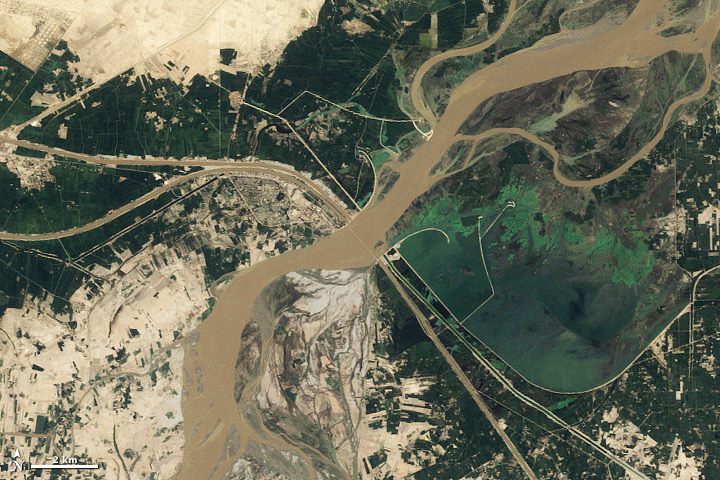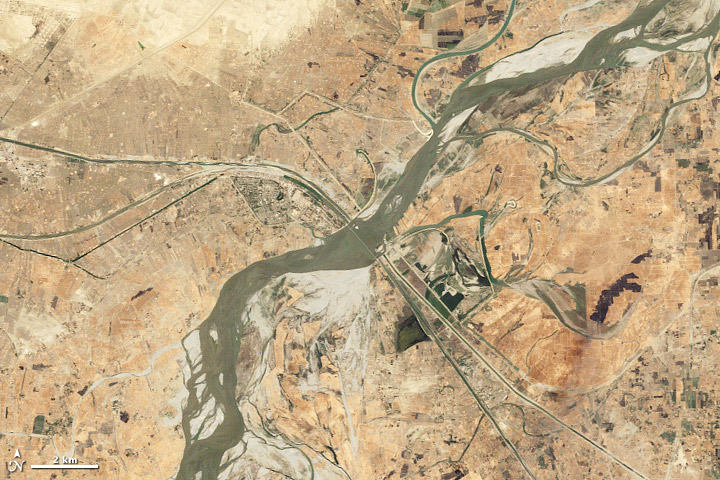

Seasonal Changes along the Indus River
Downloads
- indus_tm5_20090910_lrg.jpg (2599x2599, JPEG)
- indus_tm5_20100422_lrg.jpg (2599x2599, JPEG)
Metadata
- Sensor(s):
- Landsat 5 - TM
- Data Date: September 10, 2009
- Visualization Date: September 9, 2011
Fed by glaciers and monsoon rains, the Indus River swells and shrinks each year. Because the river irrigates millions of acres of farmland, the strong seasonal cycle changes not just the river, but also the surrounding landscape.
The images above show a small portion of the Indus River around the Guddu (or Gudu) Barrage, just south of the border between Punjab and Sindh Provinces in Pakistan. The Thematic Mapper on the Landsat 5 satellite acquired these natural-color images of the area on September 10, 2009 (top), and April 22, 2010 (bottom).
A type of dam, the Guddu Barrage diverts water from the Indus for irrigation during Pakistan’s two main growing seasons—Kharif (May to November) and Rabi (November to May). Some water is stored in the holding structure east of the river.
The Indus River typically crests in July and August. Although water levels recede somewhat by September, the river remains high, and Kharif, or summer, crops peak around that time. On September 10, 2009, muddy water fills the river channel, abundant water rests in the holding structure, and lush vegetation carpets the land on either side of the river.
By April 22, 2010, the water level in the Indus has dropped considerably. But the more noticeable changes occur in the surrounding landscape. Rabi, or winter, crops have mostly been harvested, and the landscape appears in shades of brown, rust, and beige. Hardly any water remains in the holding structure east of the barrage, having been consumed by the irrigation of summer and winter crops.
Just three months after Landsat acquired the image from April 2010, unusually heavy monsoon rains caused historic floods. In the long run, however, water is scarce in Pakistan, and farmers depend on irrigation from the Indus to tease crops out of an arid landscape. Residents of this region have relied on the river to support agriculture for 4,000 years.
More information and images of seasonal changes around the Guddu Barrage are available through the new World of Change feature on the Indus River.
References
- Dettman, D.L., Kohn, M.J., Quade, J., Ryerson, F.J., Ojha, T.P., Hamidullah, S. (2001). Seasonal stable isotope evidence for a strong Asian monsoon throughout the past 10.7 m.y. Geology, 29(1), 31–34.
- Encyclopedia Britannica. (2011). Gudu Barrage. Accessed August 13, 2011.
- Encyclopedia Britannica. (2011). Indus River. Accessed August 23, 2011.
- Food and Agricultural Organization of the United Nations. (2004). Fertilizer use by crop in Pakistan. Accessed August 13, 2011.
- Immerzeel, W.W., Droogers, P., de Jong, S.M., Bierkens, M.F.P. (2009). Large-scale monitoring of snow cover and runoff simulation in Himalayan river basins using remote sensing. Remote Sensing of Environment, 113, 40–49.
- United Nations Environment Programme. (1998). Land Cover Assessment and Monitoring: Pakistan. Accessed August 13, 2011.
NASA image by Robert Simmon and Jesse Allen, based on Landsat 5 data from the USGS Global Visualization Viewer. Caption by Michon Scott.
This image record originally appeared on the Earth Observatory. Click here to view the full, original record.